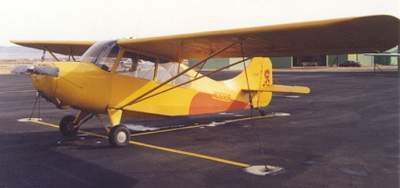Information Included In NTSB Factual Report
One of the basics we all learn in primary flight training is that carburetor ice is not something that is encountered only in the wintertime. A factual report from the NTSB stemming from an accident which occurred on August August 24, 2018 in Hanson, MA would seem to bear that out.

According to the report, the accident involved an Aeronca 7AC Champion which was substantially damaged when it impacted terrain shortly after takeoff from Cranland Airport (28M), Hanson, Massachusetts. The commercial pilot was fatally injured and the passenger was seriously injured.
A review of airport security video showed the airplane about 100 ft above ground level as it passed the departure end of the runway during takeoff. The airplane was not climbing and began to bank to the left; the left turn continued as the airplane descended behind trees and impacted terrain. The video also indicated that the airplane operated at idle engine power on the ground for about 7 minutes before beginning the takeoff roll.
First responders reported that the airplane came to rest in a nose-down, near-vertical position and that they had to move the airplane in order to perform rescue operations. The passenger stated to a first responder that the airplane "stalled."
According to FAA records, the pilot held a commercial pilot certificate with ratings for rotorcraft-helicopter, instrument helicopter, and private pilot privileges for airplane single-engine land and sea. The pilot was issued a first-class FAA medical certificate on October 10, 2017, with no limitations. According to the pilot's logbook, he had accumulated 195.7 hours of civilian flight experience, of which 4 hours were in the accident airplane in the previous 3 years.
According to FAA records, the airplane was manufactured in 1946. It was equipped with a Continental Motors Inc. C90 series, 90-horsepower engine that drove a fixed-pitch propeller. According to airplane maintenance logbooks, an annual inspection was completed on October 1, 2017, at a total time of 1,521.4 hours and a tachometer time of 3,215.1 hours. Following the accident, the tachometer indicated 3,325.1 hours.
The airplane was flown the day before the accident by the owner's son and the accident pilot. The owner's son reported that there were no anomalies with the airplane during their flight, which lasted about an hour. He stated that he usually applied carburetor heat while operating the engine at idle power on the ground because of the "carburetor icing possibilities."
The engine operating instructions stated that, during the pretakeoff ground test (engine run-up), the carburetor heat control should be moved "to full HOT position, and observe decrease in engine speed if air heater and control are operating properly. [Then] return control to full COLD position." The instructions noted, "under some conditions, ice may form in the carburetor during ground test. It must be eliminated before takeoff."
The 1552 recorded weather observation at Plymouth Municipal Airport (PYM), Plymouth, Massachusetts, about 8 miles southeast of the accident location, included wind from 210° at 9 knots, 10 miles visibility, clear skies, temperature 27°C, dew point 12°C; and an altimeter setting of 30.20 inches of mercury.
The carburetor icing probability chart from FAA Special Airworthiness Information Bulletin (SAIB): CE-09-35 Carburetor Icing Prevention, showed a probability of serious icing at glide power at the temperature and dew point reported at the time of the accident.
The carburetor hot air inlet was impact crushed aft. Carburetor heat control continuity was confirmed from the airbox to the cockpit, and the control was cut to facilitate further examination. The control could not be moved as a result of impact damage. The carburetor was removed and disassembled. The gasket was examined with no anomalies noted. The float assembly remained intact with no anomalies noted. The butterfly valve and fuel pump operated when the throttle arm was moved by hand. The needle and seat remained in place. The carburetor bowl was examined and contained brownish fluid similar to the water in the bog; the fluid smelled similar to 100LL aviation fuel.
An exemplar airplane with a Continental Motors Inc. C90 engine was started and the fuel selector was moved to the OFF position. The engine operated for 31 seconds before the engine lost total power without sputtering.
The airplane was restarted and operated at idle power for about 5 minutes. After that time, the engine was shut down and condensation was noted on the carburetor and intake of the engine. At the time of the test, the ambient temperature was 28°C and the dew point was 15°C, which showed a probability of serious icing at glide power on the Carburetor Icing Probability Chart.
FAA Special Airworthiness Information Bulletin (CE-09-35) – Carburetor Icing Prevention, stated that:
…pilots should be aware that carburetor icing doesn't just occur in freezing conditions, it can occur at temperatures well above freezing temperatures when there is visible moisture or high humidity. Icing can occur in the carburetor at temperatures above freezing because vaporization of fuel, combined with the expansion of air as it flows through the carburetor, (Venturi Effect) causes sudden cooling, sometimes by a significant amount within a fraction of a second. Carburetor ice can be detected by a drop in rpm in fixed pitch propeller airplanes and a drop in manifold pressure in constant speed propeller airplanes. In both types, usually there will be a roughness in engine operation.
(Source: NTSB. Image from file. Not accident airplane)
 ANN's Daily Aero-Term (04.28.24): Airport Marking Aids
ANN's Daily Aero-Term (04.28.24): Airport Marking Aids Aero-News: Quote of the Day (04.28.24)
Aero-News: Quote of the Day (04.28.24) ANN's Daily Aero-Linx (04.28.24)
ANN's Daily Aero-Linx (04.28.24) Aero-News: Quote of the Day (04.29.24)
Aero-News: Quote of the Day (04.29.24) ANN's Daily Aero-Linx (04.29.24)
ANN's Daily Aero-Linx (04.29.24)



